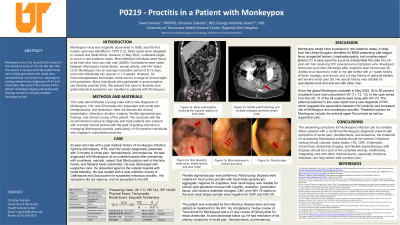Sunday Poster Session
Category: Colon
P0219 - Proctitis in a Patient with Mpox
Sunday, October 22, 2023
3:30 PM - 7:00 PM PT
Location: Exhibit Hall

Has Audio

Christian Salcedo, MS, MD
University of Tennessee Health Science Center
Memphis, TN
Presenting Author(s)
Dawit Jowhar, MD, PhD, Christian Salcedo, MS, MD, George Nicholas. Verne, MD
University of Tennessee Health Science Center, Memphis, TN
Introduction: Monkeypox virus was originally discovered in 1958 with its first human case identified in 1970. Most cases since then were relegated to Central and West Africa; however, in May 2022, outbreaks began to occur in non-endemic areas. A majority of the affected individuals were found to be men who have sex with men (MSM), and correlations were noted between Monkeypox transmission, sexual activity, and HIV status. Monkeypox has an average incubation period of 6-13 days, and most individuals can recover in 1-2 weeks. However, for individuals most at risk, there can be a range of clinical signs and symptoms. These range from mild (fever, headache, back pain, muscle aches, lack of energy, and lymphadenopathy) to severe (skin lesions leading to bacterial infection, intravascular depletion and shock, pneumonia, respiratory distress, corneal infection, encephalitis, and death). Additionally, many individuals who participate in anal-receptive sex develop proctitis. We present this unique case to illustrate how gastrointestinal symptoms can manifest in patients with MonkeyPox.
Case Description/Methods: This case highlights the presentation of a young male with a new diagnosis of Monkeypox as well as HIV and Chlamydia who presented to the hospital with rectal pain and hematochezia. We discuss the clinical presentation, including laboratory studies and imaging. We also present flexible sigmoidoscopy findings of this case as well as the clinical course of the patient. We conclude with the recommended workup to effectively diagnose and treat patients who present with a similar clinical picture with the goal of guiding clinicians in managing Monkeypox proctitis, particularly in HIV-positive individuals who engage in unprotected anal sex.
Discussion: While the presenting symptoms for Monkeypox infection are variable, when patients present with symptoms of rectal pain, hematochezia and have a confirmed diagnosis of monkeypox, the threshold for suspecting monkeypox proctitis should be lowered. Performing diagnostic tests which include infectious workup (blood cultures, rectal swabs, checking for HIV, CMV, Chlamydia, Gonorrhea), abdominal imaging and when able, visualizing the colon using a flexible sigmoidoscopy and obtaining biopsy samples should be a part of the complete the workup. Integrating care with other teams such as infectious diseases teams to manage Monkeypox and concurrent HIV if present can help deliver well rounded care to these patients.

Disclosures:
Dawit Jowhar, MD, PhD, Christian Salcedo, MS, MD, George Nicholas. Verne, MD. P0219 - Proctitis in a Patient with Mpox, ACG 2023 Annual Scientific Meeting Abstracts. Vancouver, BC, Canada: American College of Gastroenterology.
University of Tennessee Health Science Center, Memphis, TN
Introduction: Monkeypox virus was originally discovered in 1958 with its first human case identified in 1970. Most cases since then were relegated to Central and West Africa; however, in May 2022, outbreaks began to occur in non-endemic areas. A majority of the affected individuals were found to be men who have sex with men (MSM), and correlations were noted between Monkeypox transmission, sexual activity, and HIV status. Monkeypox has an average incubation period of 6-13 days, and most individuals can recover in 1-2 weeks. However, for individuals most at risk, there can be a range of clinical signs and symptoms. These range from mild (fever, headache, back pain, muscle aches, lack of energy, and lymphadenopathy) to severe (skin lesions leading to bacterial infection, intravascular depletion and shock, pneumonia, respiratory distress, corneal infection, encephalitis, and death). Additionally, many individuals who participate in anal-receptive sex develop proctitis. We present this unique case to illustrate how gastrointestinal symptoms can manifest in patients with MonkeyPox.
Case Description/Methods: This case highlights the presentation of a young male with a new diagnosis of Monkeypox as well as HIV and Chlamydia who presented to the hospital with rectal pain and hematochezia. We discuss the clinical presentation, including laboratory studies and imaging. We also present flexible sigmoidoscopy findings of this case as well as the clinical course of the patient. We conclude with the recommended workup to effectively diagnose and treat patients who present with a similar clinical picture with the goal of guiding clinicians in managing Monkeypox proctitis, particularly in HIV-positive individuals who engage in unprotected anal sex.
Discussion: While the presenting symptoms for Monkeypox infection are variable, when patients present with symptoms of rectal pain, hematochezia and have a confirmed diagnosis of monkeypox, the threshold for suspecting monkeypox proctitis should be lowered. Performing diagnostic tests which include infectious workup (blood cultures, rectal swabs, checking for HIV, CMV, Chlamydia, Gonorrhea), abdominal imaging and when able, visualizing the colon using a flexible sigmoidoscopy and obtaining biopsy samples should be a part of the complete the workup. Integrating care with other teams such as infectious diseases teams to manage Monkeypox and concurrent HIV if present can help deliver well rounded care to these patients.

Figure: Flexible Sigmoidoscopy Images of patient presenting with Monkeypox proctitis
Disclosures:
Dawit Jowhar indicated no relevant financial relationships.
Christian Salcedo indicated no relevant financial relationships.
George Verne indicated no relevant financial relationships.
Dawit Jowhar, MD, PhD, Christian Salcedo, MS, MD, George Nicholas. Verne, MD. P0219 - Proctitis in a Patient with Mpox, ACG 2023 Annual Scientific Meeting Abstracts. Vancouver, BC, Canada: American College of Gastroenterology.

